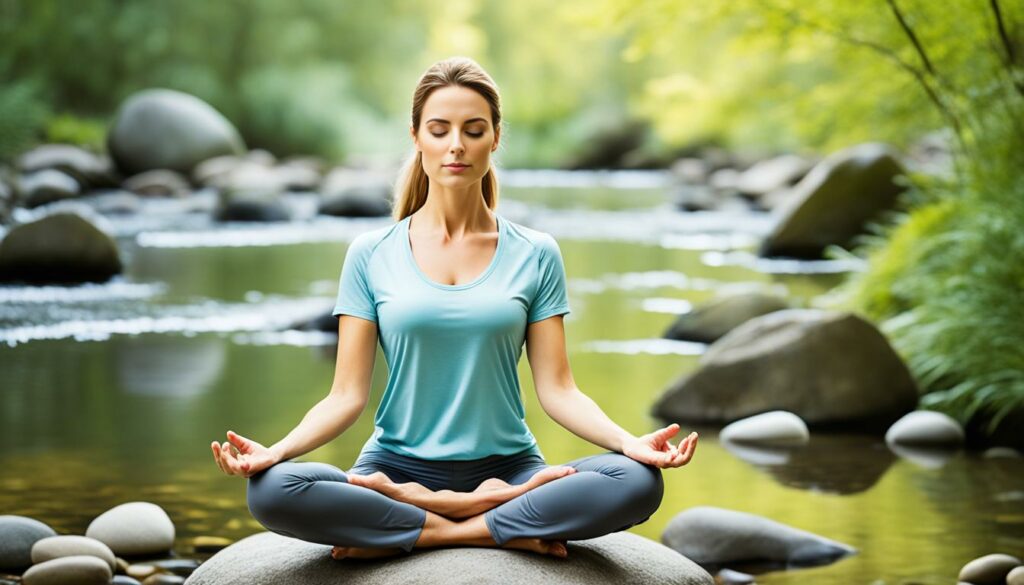Picture a calm lake on a warm day. Its surface mirrors the colorful sky as the sun sets. In this moment, you feel deep peace. Your worries seem to vanish. This feeling is inner calm. It’s a state of perfect balance in mind, body, and spirit. This lets you face life’s ups and downs with serenity.
Key Takeaways
- Inner calm is a state of tranquility where you feel at ease with yourself, others, and the world around you.
- Achieving mind balance involves incorporating mindfulness techniques, emotional intelligence practices, and self-care routines.
- Meditation, cognitive behavioral therapy, and positive psychology strategies can help unlock your inner calm.
- Developing mental resilience, emotional regulation skills, and a healthy work-life balance are essential for maintaining inner equilibrium.
- Engaging in brain fitness exercises and fostering a positive mindset can contribute to a greater sense of mental equilibrium and inner peace.
What is Inner Peace?
Inner peace means feeling calm and content. It helps us deal with life’s challenges without stress. This calm comes from feeling happy with who we are, how we fit with others, and our place in the world. To find inner peacew, we work on our mental well-being. We learn to stay calm when things are good or tough.
Characteristics of Inner Peace
Real peace lets us enjoy the moment. We don’t worry about the past or future. Key traits of inner peace are:
- Accepting ourselves and others
- Being aware of everything around us
- Keeping our emotions balanced and strong
- Showing love and understanding to all
- Feeling at peace and happy
Importance of Inner Peace
Finding inner calm is very important for our health. It means we can handle hard times better. This deep kind of peace helps us in different ways:
- It makes us less stressed and anxious
- We become smarter about our emotions and tougher
- We grow stronger bonds with others
- Our focus and work get better
- It helps our mind and body stay healthy
To build inner peace, we can do things like mindfulness and working on our emotional smarts. Yes, it takes some effort. But by working on our peace inside, we set the stage for a better, happier life.
Equanimity: The Key to Inner Peace
Finding inner peace is a journey with equanimity as the guide. Equanimity means staying calm and balanced, even when life is unpredictable. It’s a state you reach through mental and physical practices.
This mindset allows you to handle tough times without stress. Instead of acting without thinking, you face problems with a calm mind. It helps you see clearly and stay strong, avoiding negative feelings.
To build equanimity, meditation and relaxing are vital. By being mindful, you keep your mind clear during chaos. Understanding and controlling your emotions are also key steps.
Adopting equanimity leads to a profound inner peace. You start accepting life’s challenges gracefully. This new view brings calmness even in a noisy world.
| With Equanimity | Without Equanimity |
|---|---|
| Calm and balanced mindset | Easily overwhelmed by emotions |
| Acceptance of life’s challenges | Resistance and struggle against difficulties |
| Steady presence and resilience | Reactive and impulsive responses |
| Clarity and inner peace | Anxiety, worry, and stress |
Practicing equanimity is lifelong but very rewarding. With mindfulness, meditation, and managing emotions, you can keep a clear and peaceful mind. This way, you can stay calm through any situation.
Meditation: A Path to Inner Calm
Meditation is a simple yet powerful practice. It can greatly change your mental state. It helps you find inner calm and peace. With regular meditation, you’ll learn to stay calm in life’s struggles. You’ll approach challenges with a mind that is both balanced and accepting.
Benefits of Meditation
Regular meditation offers many benefits for your health. These include reduced stress and anxiety. Plus, it improves focus, emotional resilience, and self-awareness. Your immune function and overall physical health can get a boost as well.
Types of Meditation Practices
There are many types of meditation to try. Each individual may prefer one over another. Some well-known methods are:
- Mindfulness meditation: Focus on the present, without judgment, noticing thoughts and feelings.
- Breath awareness meditation: Keep focus by concentrating on your breath.
- Body scan meditation: Relax and release tension by focusing on each part of the body systematically.
- Loving-kindness meditation: Build love and kindness towards yourself and others.

Guided Meditations for Beginners
If you’re just starting, guided meditations are great. They offer step-by-step instructions. This helps you build a routine more easily. Many apps, websites, and online sources provide guided sessions. These range from quick to longer, immersive experiences, all aimed at beginners.
Living in the Present Moment
Embracing the present moment can lead you to inner peace and tranquility. By focusing entirely on where you are now, you let go of past struggles and future worries. This helps you live life calmly and with an open heart.
Practicing mindfulness and staying in the present can change how you see things. It offers powerful ways to stay in the moment.
Mindfulness Techniques
Mindfulness uses practical steps to help you live for today. One key skill is mindful breathing. You pay close attention to each breath you take.
Other methods include body scans and practices like mindful eating. They help keep you fully attentive and anchored in the present.
Benefits of Present Moment Awareness
Staying present has many benefits, like reducing stress. It stops constant thoughts about the past and future. This helps you focus more on what you are doing now.
It also makes you appreciate life more, enjoying every moment with gratitude. This brings inner joy and peace.
Practicing being mindful leads to peace. Letting go of everyday noise helps you feel calm and clear. It helps you deal with hard times and cherish happy moments with your whole being.
Cultivating a Positive Mindset
Embracing a positive mindset helps you find inner peace and mental well-being. It’s about focusing on the good. Replace negative thoughts with positive affirmations. This way, you develop a more optimistic life outlook. It leads to a greater sense of inner calm.
Gratitude Practices
Gratitude practices are very helpful. They include keeping a gratitude journal or saying thanks every day. Doing this shifts your perspective. You start to appreciate the present moment more. Consciously focusing on what you’re thankful for helps you see life’s positive side. These practices greatly improve your mental health.
Positive Self-Talk
Positive self-talk changes how you think about yourself. It counters self-criticism. By using positive affirmations, you shift your inner voice to be kinder. Gradually, you develop a more positive mindset. This leads to inner calm and better well-being.
Cultivating a positive mindset takes time and effort. It’s important to be patient and keep trying. Include things like gratitude journaling and affirmations in your daily life. These practices help the mind focus on the good. They bring more peace and contentment.
| Positive Mindset Practice | Benefits |
|---|---|
| Gratitude Journal | Cultivates appreciation, shifts perspective, promotes positivity |
| Positive Affirmations | Counters negative self-talk, builds self-confidence, enhances self-compassion |
| Mindfulness Meditation | Reduces stress, improves focus, promotes present-moment awareness |
Developing Self-Love and Self-Acceptance
Cultivating self-love and self-acceptance leads to inner peace. You just have to accept who you really are. Stop the self-criticism and start a life full of peace and joy.
Overcoming Self-Criticism
Self-criticism can stand in the way of feeling peaceful inside. Often, we talk down to ourselves, focusing on what we think are our flaws. Yet, practicing kindness towards ourselves can help. Start with kind and understanding words. This can change your negative thoughts to positive ones, overcoming self-criticism.
Embracing Your Authentic Self
Being true to yourself is empowering. It’s about recognizing what makes you special and embracing it. This includes how you act and what you believe in. By doing so, you feel whole and at peace. It also means not living up to others’ expectations but to your own.

Building self-love and acceptance requires effort but the rewards are big. You start valuing yourself more. You appreciate your strong points and accept your weaknesses. This leads to a happier, more complete life.
- Practice self-love affirmations and positive self-talk
- Engage in self-care activities that nurture your mind, body, and spirit
- Surround yourself with supportive individuals who uplift and accept you
- Celebrate your unique talents and accomplishments
- Forgive yourself for past mistakes and embrace growth opportunities
Self-Care Rituals for Inner Calm
To find inner calm, tackle both mind and body. Starting a self-care routine acts like a peaceful haven in our busy lives. It ensures you keep your balance and inner peace.
Physical Self-Care Practices
Doing physical self-care is key to lowering stress and feeling relaxed. Activities like yoga, walking, or riding a bike are great. They let out tension and make you feel good.
Eating well and getting enough sleep are also important. They refresh your body and mind. This helps in staying calm.
Mental and Emotional Self-Care Practices
Taking care of your mind and emotions is vital for peace inside. Writing in a journal helps to understand your feelings. This makes it easier to deal with them.
Doing things you enjoy, like reading or gardening, is a big stress reliever. It helps you find mental peace.
Add relaxation activities to your routine for extra benefits. Breathing exercises and muscle relaxation calm the mind. They fight anxiety and bring deep inner peace.
Finding a balance between physical and emotional health is vital for peace. This creates a strong, peaceful core in a busy world.
Strategies for Mind Balance
To find mind balance and inner calm, you need a mix of methods. These can include mindfulness, relaxation, and cognitive tricks. They help you feel more balanced and peaceful every day.
Mindfulness Exercises
Mindfulness techniques are key to finding inner calm. They keep you focused in the now. Practices like feeling your body, focusing on breath, and moving mindfully improve your focus. This lowers stress and brings a calm mind.
Relaxation Techniques
Relaxation techniques are important for letting go of stress and tension. Things like relaxing each muscle, imagining, or listening to calm music can make a big difference.
Cognitive Behavioral Strategies
Cognitive behavioral strategies change how you think and feel. They help by seeing negative thoughts differently and choosing to be grateful. This gives you a happier view and helps your emotions.
| Mindfulness Exercises | Relaxation Techniques | Cognitive Behavioral Strategies |
|---|---|---|
| Body Scans | Progressive Muscle Relaxation | Reframing Negative Thoughts |
| Breath Awareness | Guided Imagery | Challenging Irrational Beliefs |
| Mindful Movement | Mindful Listening to Nature | Practicing Gratitude |
Include these mind balance strategies in your day. They’ll help you feel calm, manage your emotions, and be well overall. You’ll face life’s ups and downs with more strength and peace.
Quieting the Mind
Achieving inner peace means quieting the mind. Journaling and nature therapy are helpful. They create space for thought and connection with the now. This practice makes us less stressed and more peaceful.
Journaling for Mental Clarity
Writing in a journal is powerful. It helps to clear your mind. By writing feelings down, you process them better. This lets you release worries and find peace. Mindful writing is like therapy. It helps you see things clearly and be calm in the chaos.
Nature Therapy
Spending time outside can be very calming. Nature’s beauty is powerful. It lets you be in the moment and forget your worries. The natural world’s sights and sounds help you find peace.
- Practice journaling regularly to process thoughts and emotions
- Spend time in nature, such as parks, forests, or beaches
- Engage in mindfulness practices like forest bathing or nature meditation
- Observe the sights, sounds, and scents around you to stay present
Try journaling and spending time in nature for inner peace. These acts can offer a break from our busy minds. They help us be calmer and more at peace.
Finding Balance and Harmony
Finding peace inside yourself can be a hard but rewarding journey. It’s all about balancing every part of your life. With the right tips for work-life balance and holistic well-being, you can feel calm inside and out.
Work-Life Balance Strategies
In today’s busy world, finding the right balance between work and life is key. You need to set aside time for your job and personal life without feeling overwhelmed. Here’s how to mix them well:
- Set clear boundaries and learn to say no to unnecessary commitments.
- Prioritize self-care by dedicating time for activities that nourish your mind, body, and soul.
- Practice effective time management techniques to avoid overwhelm and burnout.
- Cultivate hobbies and interests outside of work to maintain a well-rounded life.
Holistic Well-being Practices
Focusing on holistic well-being can have a big effect on how you feel inside. It’s about caring for your whole self, from body to soul. Some good practices include:
- Yoga: Combines physical postures, breath work, and meditation to boost body and mind.
- Tai Chi: Uses gentle moves, deep breaths, and focused thinking for a calm mind and body.
- Qigong: An ancient practice from China that works on body, breath, and mind for energy.
These mind-body balance techniques do more than just keep you fit. They help you find a deeper connection within yourself, leading to a strong sense of inner peace.
Make life harmony practices part of your every day. This builds a bridge between your personal life and work, leading to a healthier, more content you.
| Practice | Description | Benefits |
|---|---|---|
| Yoga | Combines physical postures, breath work, and meditation. | Flexibility, strength, mindfulness, stress relief. |
| Tai Chi | Gentle movements, focused breathing, and mental concentration. | Improved balance, coordination, and relaxation. |
| Qigong | Coordinated body movements, breathing techniques, and mental focus. | Cultivates vital energy, reduces stress, and promotes overall well-being. |
Embracing Acceptance and Non-Judgment
To find peace within, it’s crucial to change how we see things. This means welcoming acceptance and shelving our judgment. By dropping expectations and showing kindness, you’ll find it easier to face life’s hurdles.
Letting Go of Expectations
Finding inner peace begins by shedding expectations about yourself and others. Holding on too tight can lead to letdowns and frustration. Open-mindedness helps you go with the flow, making life less of a struggle.
Learning acceptance techniques, like meditation, and changing how you think, can make a big difference. By releasing control, you make room for peace of mind. This brings calm and helps judgment fade away.
Practicing Compassion
Being kind, whether to others or yourself, is key to finding peace. Treating life with empathy and patience leads to less judgement and more calm.
Practicing self-kindness with letter writing or meditation can improve your relation with yourself. Also, sending good wishes to others can boost your understanding and empathy.
When you welcome acceptance and less judgment, life’s trials seem easier to handle. There’s a newfound peace and strength to weather the storms.
Building Resilience and Emotional Intelligence
Life throws many challenges our way. To face them, we need to be resilient and emotionally smart. These skills help us deal with hard feelings and stay balanced, even when things get tough.
Emotional Regulation Techniques
Learning to keep calm inside is key. Emotional regulation means finding out why you feel as you do and handling those feelings well. Some ways to do this are:
- Identifying and labeling emotions
- Practicing mindful breathing exercises
- Engaging in cognitive restructuring
- Utilizing coping strategies for difficult emotions
Stress Management Practices
Stress can block our path to peace. That’s why managing stress is so important. With the right tools, you can grow inner peace and a steady emotional state. Some top stress-busting methods are:
| Technique | Description |
|---|---|
| Progressive Muscle Relaxation | A method of systematically tensing and releasing different muscle groups to promote relaxation. |
| Visualization | Using mental imagery to create a calming, peaceful, and serene inner experience. |
| Time Management Strategies | Organizing and prioritizing tasks to reduce feelings of overwhelm and increase productivity. |

Working on resilience and emotional intelligence is like training for tough times. It helps us deal with life’s storms gracefully, keep our cool, and feel better overall.
Conclusion
Finding inner peace and mind balance is a journey of change. It takes steady effort, time, and being open to new holistic self-care routines. You can start this by adding things like meditation, staying aware, looking positively at life, and emotional well-being practices. These can help you find deep calm and peace inside.
Inner calm is not escape from life’s ups and downs. It’s about facing them calmly and openly. Find what works best for you among the inner calm strategies. This could be being thankful, being gentle with yourself, or enjoying time in nature.
As you begin this journey, go easy on yourself. It takes time and practice to find your inner calm. Make these methods part of your daily life. Focus on taking care of yourself. Soon, you’ll notice you’re more balanced, strong, and happier overall.
Source Links
- https://www.mindful.org/inner-calm-the-key-is-letting-go/
- https://standinbalance.com/peace/
- https://www.calm.com/blog/inner-peace

